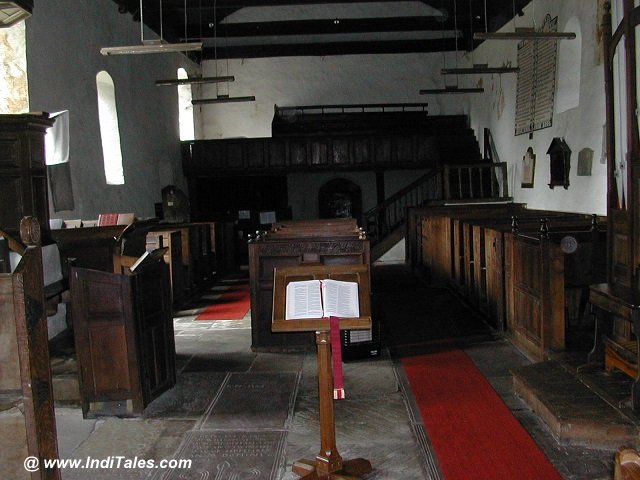

We discover some places with some people in such an intimate manner that the place and the people are intertwined forever in our minds. South Wales in my memory would always be associated with Mary Newman. I saw it through her eyes, through her memories and through her home and family.
One fine summer morning, I boarded a train to South Wales. I was going there to meet Mary Newman – a 74-year-old Welsh lady who was introduced to me by a common friend in Delhi. Around 10:30 AM, I was at my designated station and Mary was there to receive me. After exchanging pleasantries, she asked me if I wanted to go home and have some English lunch or do I want to see the mountains and some old relics of South Wales? The choice was obvious – I wanted to see the place. So, we started driving around the black mountains around Abergavenny and on the way saw some remains of the Roman Era in South Wales.
Driving Around South Wales
Ancient Church


Our first stop was at an obscure wooden church dating back to 8th CE. The structure, as well as the interiors of the church, still exist as they were when it was built. The simple yet graceful architecture is probably a reflection of the time it belongs to.
Roman Baths at Caerleon


This was my first introduction to Roman baths. Later I would see them in detail at world heritage city of Bath and then in Budapest. I could not have asked for a better guide than Mary. She explained me the Roman rituals of the bath. Apparently, Sunday was a day meant for bathing and bathing meant public bathing in a common bath in the city. At the museum, we saw small instruments that were used during bathing – for scrubbing the skin etc.
An open swimming pool was meant to be for the cold bath and a pool indoors was meant for a hot bath. I remember a room full of small pillar-like formations that I was told were used to control the temperature of the water. I could not gather the mechanics but I could gather the love for this weekly bathing ritual.
Roman Amphitheatre


A little distance from the ruins of Roman baths lies the complete amphitheater in Britain & not just South Wales. It is a circular ground, much like the modern-day sports stadium, surrounded by slanting high seats. This circle of seats is broken at regular interval by the passage that I assume is for the actors to enter and exit. One can only imagine how the actors wearing heavy costumes would do their acts in the ground surrounded by audience all around.
As of now, it is a kind of picnic place where families come and enjoy, especially on a sunny day.
Read More – How to differentiate between a Roman & a Greek Amphitheatre
Raglan Castle


After soaking in the Roman ruins we moved towards Monmouth town where Mary lives. On the way, we stopped at the Raglan castle in the village of Raglan. It is a 15th CE castle made by the families like Somersets. Even in its ruined state, the castle in stone looks beautiful.
Raglan castle is best known for its hexagonal tower that is also known as the Yellow Tower of Gwent. Not much remains of this tower but you can still see its vantage position. Even the castle gate is flanked by two hexagonal towers. We went up and down, saw the castle from various angles including the top view where you can see the moat around the tower. This was my introduction to English castles – though I did a few in Scotland earlier.
I had no idea that there were so many heritage places to see in South Wales.
Monmouth – South Wales


We reached Monmouth by evening and sat down in Mary’s Garden for a cup of tea. As we sipped tea, Mary explained me the various flowers in her garden. You have to see an English home with a perfectly manicured garden to know their fondness for lovely gardens. Apart from common English flowers, there was a Peony in Mary’s garden. Now, Peony is a Chinese flower. I never expected to see it in a garden in Wales of all the places. It is then that Mary told me that she has been tending to this plant for a good 10 years and this is the first bud ever to come up. The dark pink petals were still held tightly together. I so wanted to see the Peony bloom, the flower was in hurry. Mary did send me a picture of the flower about a week later.
We were talking about a rose in her garden when Mary used the word ‘Gulab’ for it. Her diction was so desi that I was surprised. She spoke about being born in India and growing-up in Lahore where her father published a newspaper. Mary told me hilarious stories about fooling people in India with her impeccable Hindi. She spoke about her deceased husband and their travels around the world.
Walking along the Wye River
After tea, we took a walk along river Wye, along which the town of Monmouth is situated. I heard more stories from Mary and she asked me ‘Do you want to meet my husband?’. I was confused – wasn’t he dead? Nonetheless, I nodded and we started walking. She stopped at a grave not too far from the river and pointed. My heart missed a beat. She pointed to his epitaph that was a Sanskrit Shloka from the Upanishads. I suddenly realized how strong their connection with India and its culture is.
Mary’s house was a quaint 400-year-old house. What stays with me is the books all over her house. There was a dedicated room with all walls full of books, but then there were books in every room including washrooms. In the middle of the living room sat a Piano adding to the grace of the old house. Mary had records of each and every owner who has lived in the house. British do have some fetish for names and dates.
Monnow Bridge


Next day morning after breakfast, Mary left for her church choir – it was a Sunday. She handed me a map of Monmouth and told me to see a few things in town. She asked me not to miss the Monnow Bridge. I obediently walked to the Monnow bridge that stands on the confluence of Rivers Wye and Monnow.
What makes the Monnow bridge at Monmouth unique is the bridge tower or the gate tower still standing at one end of the bridge. This bridge tower means that at some point in time this was a part of fortification of the city or a part of some fort. I later gathered this is the only remaining bridge tower in the whole of Britain. Built in late 13th CE, this bridge also served as a toll gate at some point in time. Before this stone bridge came up, there used to be a wooden bridge just like Clapton Bridge at Stratford upon Avon. I love the arches on the piers of the bridges. There is another lovely bridge on the same Avon River in Bath.
Monnow bridge tower looks like a lonely tower overlooking the small town it was built to serve. The river is not quite wide here so the bridge is rather small. As of now, this is a pedestrian-only bridge, so you can leisurely walk without worrying about any traffic.
I walked around the small town that has an air of comfort and warmth around it.
Saying Goodbye to Mary and South Wales
After my walk, I came back to Mary’s place for lunch. She cooked a nice vegetarian lasagne for me – the most delicious lasagne I have ever had. Her daughter and grandchildren came over to meet me. Mary wanted to introduce them to a software engineer from India. Over hearty conversations, we had food and said our goodbyes.
Mary dropped me at the station, she again made sure that she did not take the expressway but the old roads so that I can enjoy the black mountains a bit more. She lamented the fact that Monmouth is no longer connected with the rail network which it used to be once.
I was emotional and I told Mary ‘When I get to your age, I wish I can live a life like yours – welcoming people into my home & my heart’. With a gentle hug, we parted ways, hoping to meet sometime somewhere again.
What visiting Mary Newman in Wales did to me was that not only I discovered the lovely wales from the eyes of a local, but also got to enjoy the warmth of their hospitality. This is something that I would cherish for a long time to come.
To find more information about Wales – check out the Visit Britain website.
This post has been written in partnership with Mercury Travels’. Do check out their upcoming offers on their Facebook and Instagram pages.




